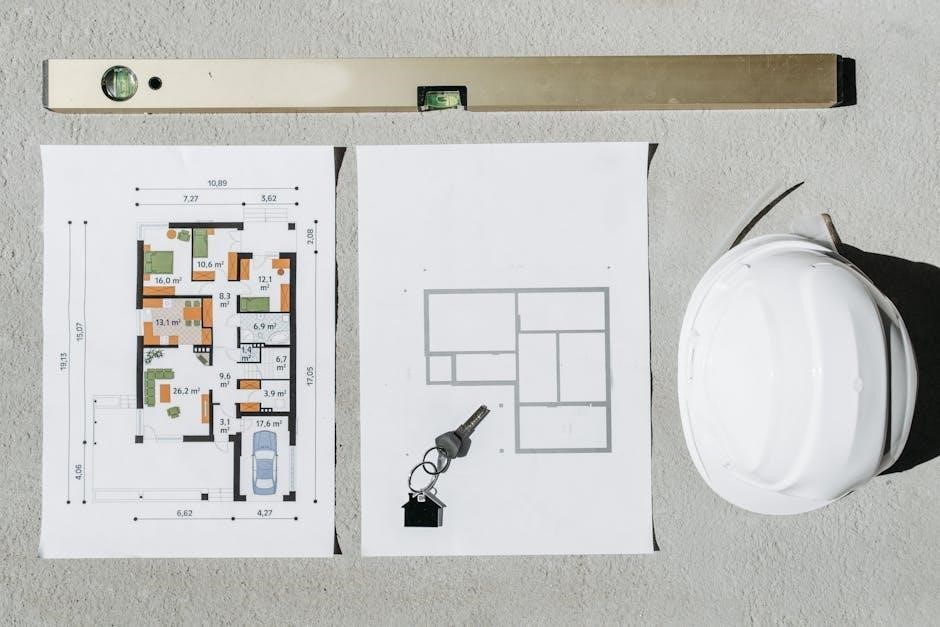Understanding snowboard measurements is crucial for optimal performance and comfort. Key metrics like length‚ width‚ and flex determine how a board responds to your movements. Proper fit enhances control‚ making every ride more enjoyable. This guide breaks down the essentials to help you make informed decisions and find your ideal snowboard.
Understanding the Importance of Proper Fit
A proper-fitting snowboard is essential for optimal performance‚ comfort‚ and control. A board that matches your height‚ weight‚ and riding style ensures better balance‚ easier turning‚ and reduced fatigue. Incorrect sizing can lead to poor edge hold‚ difficulty in maneuvering‚ and a less enjoyable experience. A well-fitted snowboard enhances responsiveness and stability‚ allowing you to ride with confidence. Investing time in finding the right fit guarantees improved performance and a more satisfying time on the slopes‚ regardless of your skill level or riding style.

Key Snowboard Measurements
Snowboard measurements include length‚ width‚ and flex‚ each impacting performance. Length affects control and stability‚ width ensures boot compatibility‚ and flex influences responsiveness and riding style.
Snowboard Length: How to Measure and Choose the Right Size
Snowboard length is measured from the tip to the tail‚ typically ranging from 130cm to 165cm. A proper fit is essential for control and stability. As a general rule‚ the snowboard should reach between your chin and nose when stood upright. Your height and weight are key factors—shorter boards are easier to maneuver‚ while longer boards offer stability at higher speeds. Use a snowboard size calculator to find the ideal length based on your height‚ weight‚ and riding style for a personalized recommendation.
Snowboard Width: Ensuring Compatibility with Boot Size
Snowboard width is measured at the waist‚ typically ranging from 24cm to 26.5cm. Proper width ensures compatibility with your boot size‚ preventing toe drag or heel hang. Boot size is critical—larger boots need a wider board for optimal performance. If your boots overhang‚ it can cause poor edge control and discomfort. Use a size chart to match your boot size with the board’s width for a precise fit. This ensures better maneuverability‚ stability‚ and overall riding comfort‚ making your snowboarding experience more enjoyable and efficient.
Snowboard Flex: Determining the Right Flex for Your Riding Style
Snowboard flex refers to the board’s stiffness‚ ranging from soft to stiff. A softer flex is ideal for beginners or freestyle riders‚ offering forgiveness and easier turns. Medium flex balances versatility for all-mountain riding‚ while stiff flex suits advanced riders needing precision and stability at high speeds. Choosing the right flex enhances performance‚ ensuring better control and responsiveness. It’s essential to match your riding style and ability level to the board’s flex for optimal comfort and maneuverability on the slopes.
Factors Influencing Snowboard Size
Height‚ weight‚ and riding style are key factors in determining snowboard size. Boot size also plays a role in ensuring proper fit and performance.
Height and Weight: The Primary Considerations
Height and weight are the most critical factors in determining snowboard size. A board’s length should generally reach between your chin and nose when stood upright. Your weight influences the board’s ability to float and respond‚ with lighter riders needing less surface area and heavier riders requiring more. Proper sizing ensures better control and performance. Use a snowboard size calculator to match your height‚ weight‚ and riding style for the best fit. This ensures optimal performance and comfort on the slopes.
Riding Style and Ability Level: Tailoring Your Choice
Riding style and ability level significantly influence snowboard selection. Beginners benefit from softer flex boards for forgiveness and ease of control‚ while advanced riders may prefer stiffer boards for precision. Freestyle riders opt for shorter‚ more maneuverable boards‚ while all-mountain riders prefer versatile lengths for various terrains. Powder snowboards are longer and wider for floatation. Matching your board to your style ensures better performance and enjoyment. Consider your skill level and terrain preferences to tailor your choice for the ultimate riding experience.
Popular Snowboard Riding Styles
Popular snowboard riding styles include all-mountain‚ freestyle‚ and powder. All-mountain boards offer versatility for various terrains‚ while freestyle boards are shorter and optimized for tricks. Powder boards are longer and wider‚ designed for floating in deep snow. Each style demands specific measurements‚ such as length‚ width‚ and flex‚ to enhance performance and rider experience. Understanding your riding style helps tailor your snowboard choice for optimal results on the mountain.
All-Mountain Snowboards: Versatility for Various Terrains
All-mountain snowboards are designed for versatility‚ excelling in diverse conditions from groomed trails to backcountry powder. Their medium flex provides stability at high speeds while remaining maneuverable in tight spaces. Typically ranging from 150-162cm in length‚ these boards feature a balanced shape‚ often with a directional or true twin design. A waist width that matches your boot size ensures optimal edge control and float in deeper snow. All-mountain snowboards are ideal for riders seeking a single board that can handle any terrain‚ making them a popular choice for everyday riding.
Freestyle Snowboards: Optimized for Tricks and Parks
Freestyle snowboards are built for creativity and precision in parks and urban terrain. With a softer flex‚ these boards are more forgiving‚ making them ideal for learners and riders perfecting tricks. Typically shorter in length (145-157cm)‚ they offer easier maneuverability and quicker rotations. A true twin shape ensures balanced performance for switch riding and aerial maneuvers. Waist widths are tailored to boot size to prevent drag and enhance edge control. Whether hitting rails‚ jumps‚ or boxes‚ freestyle snowboards deliver the pop and precision needed for technical tricks and endless fun in the park.

Boot Size and Its Impact on Snowboard Fit
Boot size significantly impacts snowboard fit‚ affecting performance and comfort. Proper fit ensures efficient energy transfer and optimal edge control for a superior riding experience.
Why Boot Size Matters for Performance and Comfort
Boot size plays a critical role in both performance and comfort on the snowboard. Properly fitting boots ensure precise control and responsiveness‚ while ill-fitting boots can lead to discomfort and reduced performance. Boots that are too tight restrict movement‚ while those too loose compromise stability. Compatibility between boot size and snowboard width is essential for optimal edge-to-edge performance. Proper fit enhances energy transfer‚ allowing for smoother turns and better overall control. Ensuring the right boot size is vital for a comfortable and enjoyable snowboarding experience.
Recommended Boot Size Ranges for Different Snowboard Widths
Matching your boot size to your snowboard’s width ensures optimal performance and comfort. For narrow snowboards (less than 240mm)‚ boot sizes typically range from 4-7 (US Women’s) or 2-5 (US Men’s). Mid-width snowboards (240-260mm) accommodate boot sizes 7-10 (US Women’s) or 5-8 (US Men’s). Wide snowboards (over 260mm) are designed for larger boots‚ sizes 10+ (US Women’s) or 8+ (US Men’s). Proper alignment prevents toe drag and ensures smooth edge control‚ enhancing your overall riding experience.

A Step-by-Step Guide to Choosing Your Snowboard
Measure Your Height and Weight: These are the primary factors in determining snowboard length.
Use a Snowboard Size Calculator: Input your height‚ weight‚ and skill level for precise recommendations.
Consider Your Riding Style: All-mountain‚ freestyle‚ or powder boards cater to different preferences.
Check Boot Compatibility: Ensure your boot size matches the snowboard width for optimal control.
Evaluate Flex: Softer flex suits beginners‚ while stiffer boards are better for advanced riders.
Visit a Shop for Expert Advice: Professionals can help fine-tune your choice.
By following these steps‚ you’ll find a snowboard that matches your needs‚ ensuring better performance and more fun on the slopes.

Advanced Tips for Fine-Tuning Your Snowboard Fit
Adjust camber profiles for better edge hold or float. Experiment with stance width and angles for personalized control. Consider edge technology for enhanced grip and stability.
Camber Profiles and Edge Technology: What You Need to Know
Camber profiles significantly impact a snowboard’s performance. Traditional camber offers responsiveness and edge hold‚ ideal for carving‚ while rocker provides float in powder. Hybrid camber blends both for versatility. Edge technology enhances grip and durability. Sharp edges excel on hard snow‚ while detuned edges reduce drag in deep powder. Serrated edges improve ice performance‚ and Magne-Traction offers exceptional control. Understanding these features helps tailor your snowboard to your riding style and terrain preferences for optimal performance.
Using a Snowboard Size Calculator
A snowboard size calculator simplifies finding the perfect board by considering height‚ weight‚ and riding style. It provides tailored recommendations for length and width‚ ensuring optimal performance. Beginner-friendly and efficient‚ these tools replace traditional charts with precise‚ customizable results. Simply input your details—height‚ weight‚ and skill level—to receive instant‚ accurate suggestions. This method ensures a fast and reliable way to narrow down your options‚ making the process of choosing the right snowboard hassle-free and effective for all riders.
Proper snowboard fit is crucial for maximizing performance‚ comfort‚ and overall enjoyment on the slopes. A well-fitting board ensures better control‚ easier maneuverability‚ and reduced fatigue. By understanding key measurements like length‚ width‚ and flex‚ riders can make informed decisions tailored to their height‚ weight‚ and riding style. Investing time in finding the right fit pays off with a more enjoyable and rewarding snowboarding experience.
Remember‚ the right size and style of snowboard can elevate your skills and confidence. Use tools like size calculators and expert guides to find your perfect match and make every ride a memorable one.